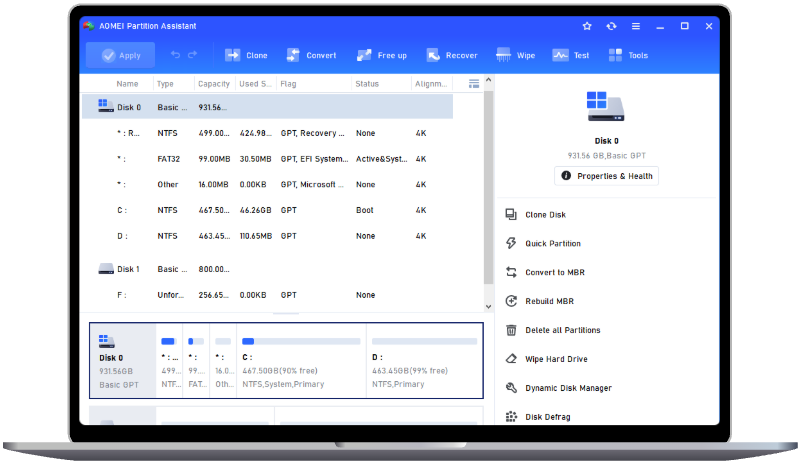How to Fix External Hard Drive I/O Error [6 Ways]
The I/O device error is a common issue. This article will guide you through understanding its root causes and offer effective solutions to make you know how to fix external hard drive I/O error on Windows 11 or 10.
Overview of I/O device error on external hard drive
An I/O device error (Input/Output device error) occurs when Windows fails to perform an input/output operation, such as reading or copying data, while trying to access a drive or disk. This can happen with various hardware devices or storage media.
✍ Common causes of the I/O device error
• The connected storage device is improperly connected, preventing the PC from detecting it correctly.
• The computer's USB port or USB card reader is damaged or faulty.
• The device driver for the storage device is outdated, corrupted, or incompatible with the connected device.
• The external hard drive, memory card, or USB drive is assigned the wrong drive letter.
• The connected device is physically damaged or dirty, affecting its functionality.
• Windows is trying to use a transfer mode that the hardware device cannot support.
✍ Common symptoms of the “I/O Device Error”
If your storage device encounters an I/O device error, you may see the following error messages:
“The request could not be performed because of an I/O device error”
"I/O error 32", "I/O error 21" or other similar "I/O error + code"
“Only part of a read process memory request was completed” or "Only part of a write process memory request was completed”
How to fix external hard drive I/OerrorWindows 11/10
Before attempting any fixes, it's highly recommended to recover or transfer data from the affected drive. The files and data on the drive are at risk of being lost permanently if the I/O error is not resolved in time.
Fix 1. Update the driver
If your computer's storage device driver is outdated, damaged, or incompatible with the attached device, it may interfere with its input/output functionality.
Step 1. Right-click the Start menu and select Device Manager.
Step 2. Expand the Disk Drives section.
Step 3. Right-click the device you want to update and select Update Driver.
Step 4. Choose Search automatically for drivers, then follow the on-screen instructions to complete the update.
Fix 2. Check and repair I/O device error on the drive
The I/O device error on an external hard drive can sometimes be resolved using the Command Prompt. It scans both the external and internal drives, repairing any disk issues to fix the problem.
Step 1. To start, type "Command Prompt" in the search bar next to the Start menu.
Step 2. Right-click the Command Prompt option and choose "Run as administrator".
Step 3. Next, enter the command chkdsk G:/f/r/x in the window and press Enter. Be sure to replace "g" with the correct drive letter for the hard drive experiencing the I/O error.
If you're not comfortable with using commands or are worried about making mistakes, you can rely on AOMEI Partition Assistant to run a CHKDSK check. With its user-friendly interface, you only need a few clicks to complete the process, making it an easy and safe alternative to command-line tools.
Step 1. Download and open AOMEI Partition Assistant, right-click the external hard drive, select “Advanced” and click “Check Partition”.
Step 2. In the check options window, here we choose “Check partition and fix errors in the partition using chkdsk.exe” and you can also choose other check options, and click “OK”.
And wait for the check program to finish. Then restart the computer.
Fix 3. Change the drive letter
When an external drive is assigned an incorrect drive letter, its I/O functionality may be compromised, as the system attempts to access a non-existent or incorrect drive.
To resolve this, you can change the drive letter without impacting the existing data. This can be done easily through Disk Management.
Step 1. Hit Windows Key + X on your keyboard, and select Disk Management from the menu.
Step 2. Right-click the USB drive to which you want to assign a persistent drive letter and select “Change Drive Letter and Paths”.
Step 3. In the pop-up window, click “Change”.
Step 4. In the next window, choose a proper drive letter for your USB drive using the drop-down menu and click “OK”.
✐ Tips: You may choose a rarely-used drive letter like M-Z, thus avoiding possible drive letter conflicts.
Step 5. You will get a prompt that some programs might rely on drive letters to run properly. Click “Yes” to continue as long as the drive letter you assign here is not occupied by another drive where the programs are installed.
Fix 4. Change the drive's transfer mode in IDE channel properties
If the transfer mode is incorrect, the OS may fail to move data from the drive to the PC, causing an I/O device error. To fix this issue, follow these steps:
Step 1. Press Windows + X together and select Device Manager from the menu.
Step 2. Expand IDE ATA/ATAPI controllers to reveal all the IDE ATA/ATAPI channels.
Step 3. Right-click the channel corresponding to the connected drive and choose Properties.
Step 4. In the Advanced Settings tab, select PIO Only in the transfer mode box for the device (usually Device 0) that corresponds to the affected drive.
Step 5. Click OK and close all windows.
Fix 5. Try clean booting your PC
To ensure the security of your PC, you can perform a clean boot to resolve potential issues, but be cautious not to disable advanced boot options.
Step 1. Type "MSConfig" in the search bar and press Enter to open the System Configuration window.
Step 2. In the window that appears, go to the Services tab, check Hide all Microsoft services, and then click Disable all.
Step 3. Next, switch to the Startup tab and click Open Task Manager.
Step 4. In the Task Manager, select all startup items and click Disable.
Step 5. Close Task Manager and return to the System Configuration window. Click OK, then restart your Windows 10 PC.
Fix 6. Format the external hard drive
If none of the previous solutions resolve the issue, you can attempt to format your hard drive. If you're unsure how to format a drive, AOMEI Partition Assistant is a user-friendly tool that provides a straightforward process to accomplish this.
Step 1. Open AOMEI Partition Assistant, and right-click “Format Partition”.
Step 2. Then choose the file system of your external hard drive, and click “OK”.
Step 3. View the pending operation and click “Apply” to start formatting.
Conclusion
I/O device errors on external hard drives can lead to significant issues if not resolved. How to fix external hard drive I/O error? Try the solutions outlined above to resolve it easily. Besides, your external hard drive may encounter other problems like external hard drive not showing up, you can also solve it with AOMEI Partition Assistant.


